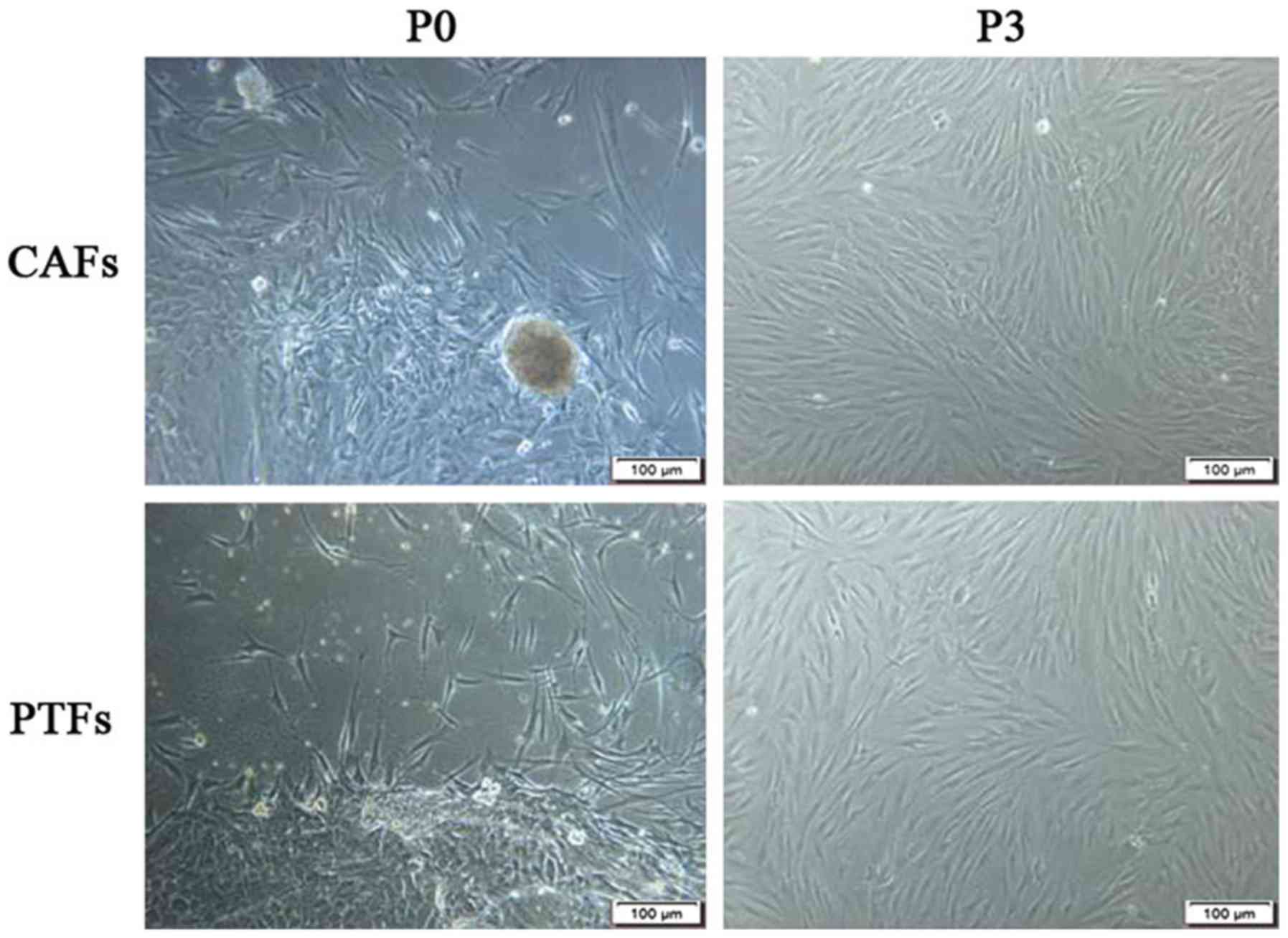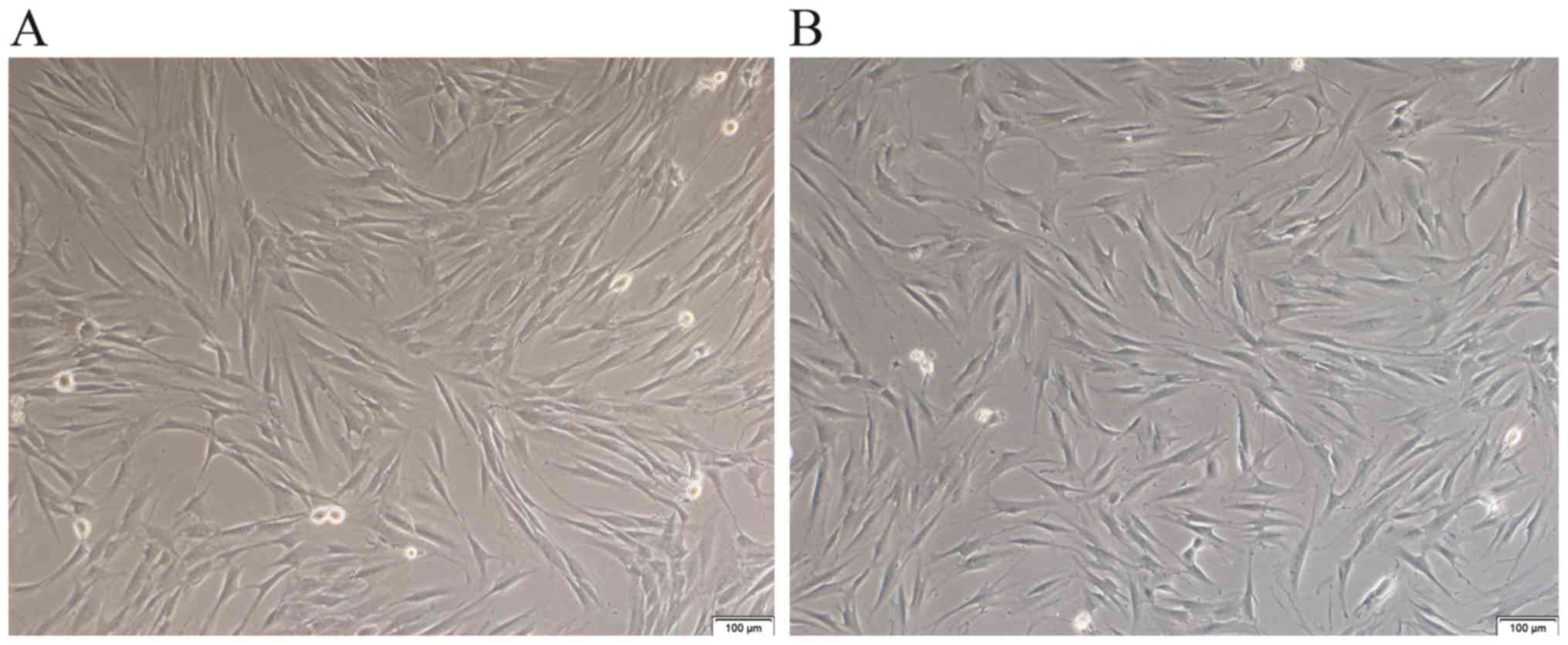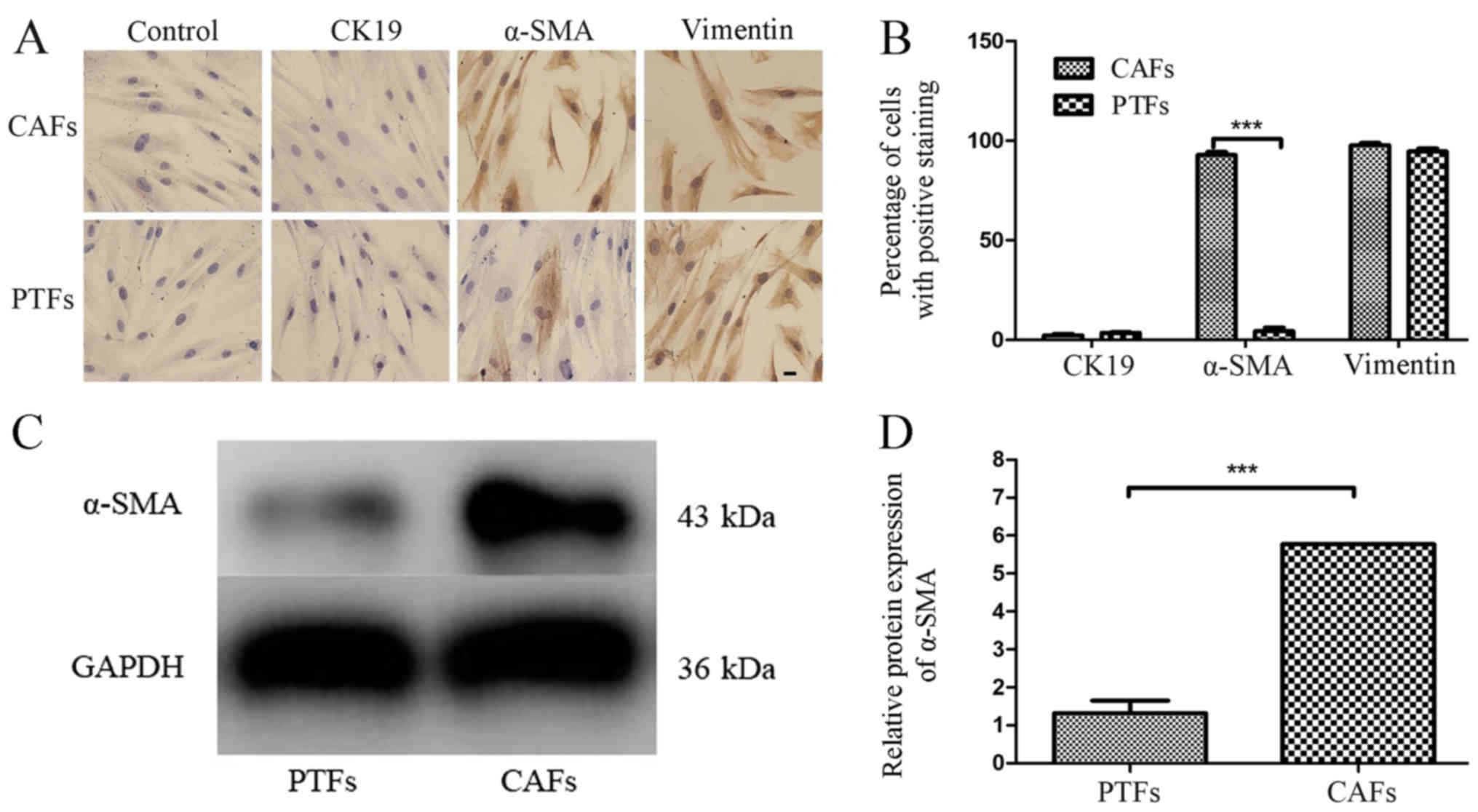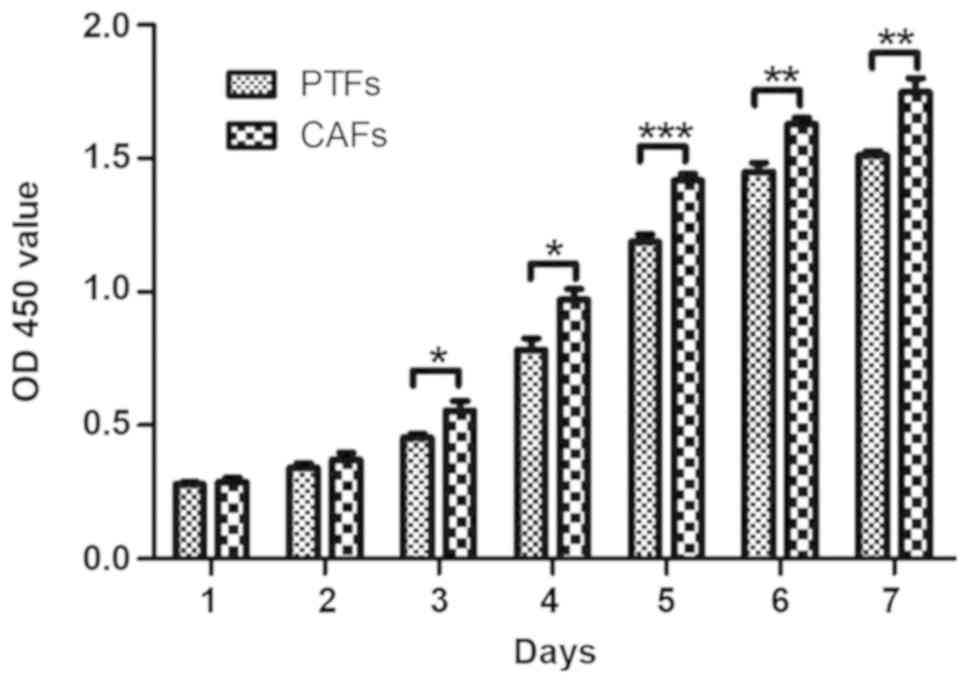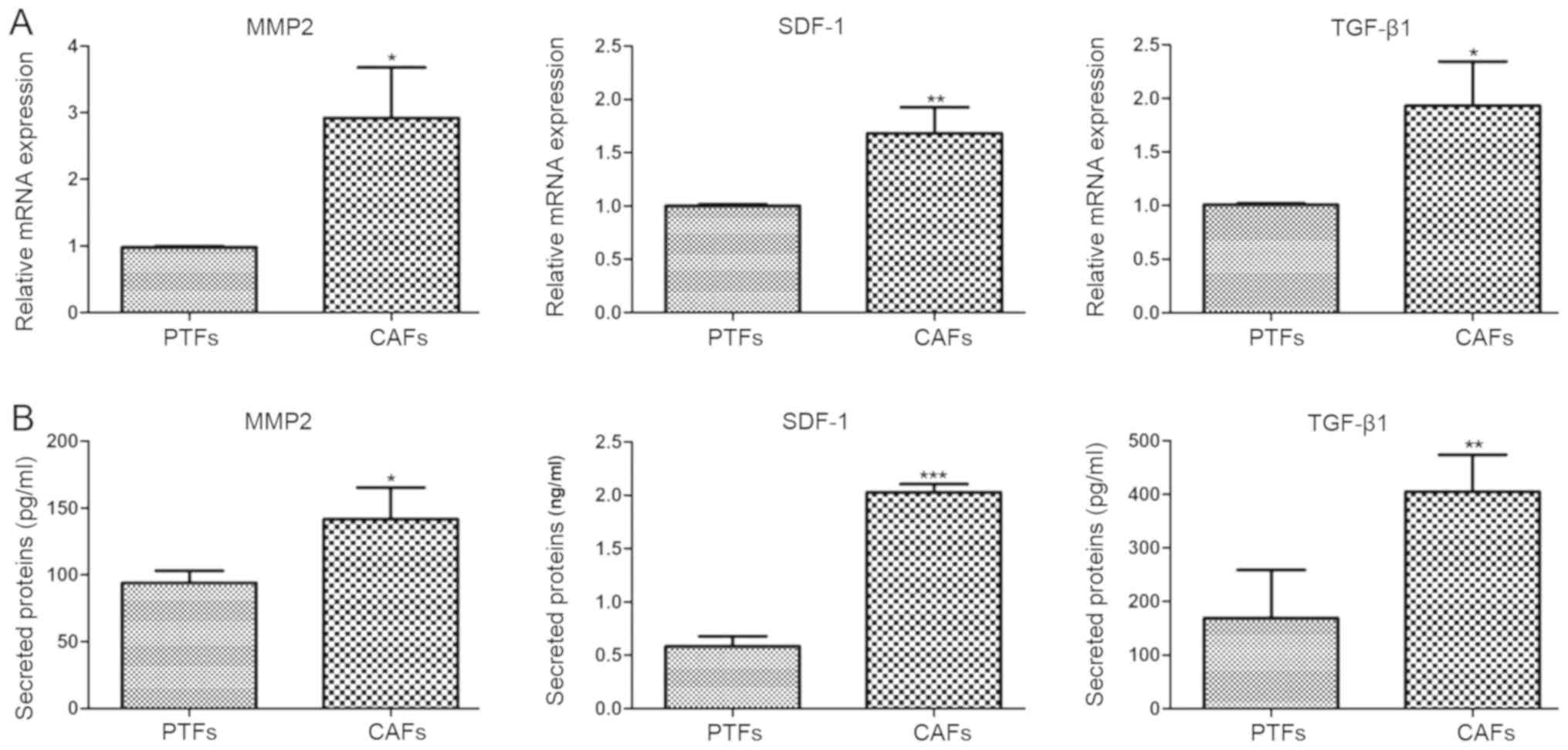Cancer associated fibroblasts are distinguishable from peri‑tumor fibroblasts by biological characteristics in TSCC
- Authors:
- Published online on: July 4, 2019 https://doi.org/10.3892/ol.2019.10556
- Pages: 2484-2490
-
Copyright: © Ba et al. This is an open access article distributed under the terms of Creative Commons Attribution License.
Abstract
Introduction
Tongue squamous cell carcinoma (TSCC) is one of the most common oral cancer types, usually characterized by the early occurrence of lymph node metastasis and poor prognosis (1–4). Though the precise mechanism of TSCC tumorigenesis remains unclear, it has become clear that the initiation and progression of tumors depends not only on the epithelial cells, but also on the interactions between the tumor stroma and tumor cells (5,6). Cancer associated fibroblasts (CAFs), also named ‘activated fibroblasts’, are the most abundant stromal cell types of the tumor stroma (7,8). CAFs modulate tumor angiogenesis, remodeling of the extracellular matrix and epithelial-to-mesenchymal transition, and also contribute to tumor recurrence and drug resistance (9,10), and thus play a major role in the initiation and progression of carcinomas (6,11). Therefore, CAFs would be effective targets for cancer treatment; the present study on CAFs may be beneficial for investigating the mechanisms of tumorigenesis and tumor progression.
CAFs have been identified to differ phenotypically and functionally from normal fibroblasts (NFs) (12,13). Compared with fibroblasts from normal oral mucosal tissue, CAFs are characterized by higher expression of α-SMA and a distinct morphology (13). This is why NFs are often used as the control when CAFs are studied (14). However, whether the behavior, phenotype and function of peri-tumor fibroblasts (PTFs) are different from CAFs in TSCC is not clear. In the present study, CAFs and PTFs were cultured from specimens of TSCC and peri-tumor tissues (confirmed by histology), from which fibroblasts were purified, and subsequently their differential biological characteristics by means of morphology observation, cell surface marker [α-smooth muscle actin (α-SMA), vimentin and cytokeratin 19 (CK19)] expression, cell viability and pro-carcinogenic cytokine expression was investigated. This information, on the one hand, will provide some benefits in further understanding stromal cell changes in tumor development, and, in turn, understanding the mesenchymal-epithelium interactions in carcinogenesis. On the other hand, it may provide further experimental evidence for PTFs as a control in the examination of CAFs in TSCC.
Materials and methods
Tissue collection
TSCC specimens and ‘histologically normal’ peri-tumor tissues (at least 1 cm from the outer tumor margin) were collected from primary tumors from 6 patients (2 males and 4 females, age 40–65 years) who underwent surgical resection at the Qilu Hospital of Shandong University between March 2016 and January 2017. The inclusion criteria included: Age 18–75 years; a Karnofsky score (15) ≥60%, and a life expectancy ≥3 months; white blood cell ≥4.0×109/l, absolute neutrophil count ≥2.0×109/l, platelet count ≥100×109/l, and hemoglobin ≥100 g/l; alanine transaminase and aspartate transaminase <2.5× the upper limit of normal, total bilirubin and serum creatinine <1.5× the upper limit of normal. Patients were excluded if they had distant metastasis or other types of cancer, had undergone surgery involving primary tumor or lymph nodes (except diagnostic biopsy), had received prior radiotherapy or chemotherapy, presented with other malignancies within 5 years, or had creatinine clearance <30 ml/min. All the resections (TSCC and peri-tumor tissues) were confirmed by clinical and histopathological examination, according to the World Health Organization and the 2010 criteria of the International Union Against Cancer (16), All research procedures were approved by the Medical Ethics Committee of Qilu Hospital, Shandong University (2016015) and informed consent was obtained from all the participants.
Separation, cultivation and purification of CAFs and PTFs
The obtained tissues (tumor or peri-tumor) were immersed in Dulbecco's modified Eagle's medium (DMEM; HyClone; GE Healthcare Life Sciences) supplemented with 2% penicillin-streptomycin (HyClone; GE Healthcare Life Sciences) for at least 30 min, and then washed with PBS (HyClone; GE Healthcare Life Sciences) three times. The tissues were minced with scalpels into 1.0×1.0×1.0 mm3 fragments and tiled on the bottom of a culture bottle. The cells were cultured in DMEM supplemented 20% FBS (HyClone; GE Healthcare Life Sciences) and 1% penicillin-streptomycin. After 3 h, the culture bottle was turned over. Cultures were incubated at 37°C in a humidified atmosphere of 5% CO2 and cell growth was observed under an inverted microscope (magnification, ×100). Upon reaching 90% confluence, the areas which epithelioid cells had grown in clusters were marked on the culture bottle when the cells were observed under the phase-contrast microscope (magnification, ×100), and according to the markers, epithelioid cells were wiped with a cotton stick dipped in 10 µl of trypsin. The remaining cells were digested with 0.25% trypsinase for 1 min; digestion was terminated with 3 ml of medium containing serum, and cells were sub-cultured into fresh bottles. Cells at passage (P)3-P5 were used in subsequent experiments.
Cell morphology observation
Morphology of the purified P3-P5 CAFs and PTFs was observed using a phase-contrast microscope.
Immunohistochemistry (IHC)
Coverslips with attached fibroblasts (at a density of 3×104 cells/cm2) were fixed with 4% paraformaldehyde for 10–20 min at room temperature. IHC procedures using the SP kit (cat. no. SP9002; OriGene Technologies, Inc.) were performed according to the manufacturer's instructions. The fixed cells were washed in PBS three times, permeabilized with 0.05% Triton for 5 min, and blocked with 4% bovine serum albumin (cat. no. A8010; Beijing Solarbio Science & Technology Co., Ltd.) for 30 min at 37°C. Subsequently, the coverslips were incubated at 4°C in a moist chamber overnight with the following primary mouse anti-human monoclonal antibodies: Anti-human CK19 (dilution, 1:100; cat. no. BM3267), anti-human vimentin (dilution, 1:100; cat. no. BM0135), and anti-human α-SMA (dilution, 1:100; cat. no. BM0002; all Wuhan Boster Biological Technology, Ltd.). PBS was used as the negative control, in place of the primary antibody. After incubation with HRP-conjugated rabbit-anti-mouse secondary antibody (dilution, 1:100 cat. no. BA1048; Wuhan Boster Biological Technology, Ltd.) for 30 min at room temperature, the coverslips were counterstained with Mayer hematoxylin (cat. no. G1080; Beijing Solarbio Science & Technology Co., Ltd.) and observed under a light microscope (magnification, ×400; Olympus BX53; Olympus Corporation, Tokyo, Japan,). Cells showing light-brown or yellow-brown grains in the cytoplasm were classified as positively stained.
Western blot analysis
CAFs/PTFs were seeded into 6-well plates (1×105 cells/well) overnight. Following this, whole-cell proteins were extracted using RIPA buffer (cat. no. R0020; Beijing Solarbio Science & Technology Co., Ltd.) and quantitated using a bicinchoninic acid protein assay kit (cat. no. PC0020; Beijing Solarbio Science & Technology Co., Ltd.), according to the manufacturer's protocols; the proteins (10 µg/lane) from different samples were separated via 10% SDS-PAGE (cat. no. AR0138; Wuhan Boster Biological Technology, Ltd.) and transferred to polyvinylidene fluoride (PVDF) membranes (cat. no. ISEQ00010; EMD Millipore). The PVDF membranes were blocked with blocking buffer containing 5% skimmed milk for 1 h at room temperature before incubation with the primary α-SMA antibody (dilution, 1:200; cat. no. BM0002; Wuhan Boster Biological Technology, Ltd.) overnight at 4°C. Protein bands were detected using the appropriate secondary antibodies (dilution, 1:2,000; cat. no. BA1092; Wuhan Boster Biological Engineering Co., Wuhan, China) for 1 h at 37°C. and ECL reagents (cat. no. 17-373SP; EMD Millipore; Merck KGaA) according to the manufacturer's protocol. Quantitative analyses were performed using ImageJ software (version 1.46; National Institutes of Health, Bethesda). GAPDH (dilution, 1:2,000; cat. no. 60004-1-Ig; ProteinTech Group, Inc.) was used as an internal control.
Cell viability analysis
Purified CAFs and PTFs (4×103 cells/well) were loaded onto 96-well plates in 100 µl complete medium (DMEM containing 1% penicillin-streptomycin and 10% FBS) and maintained in a CO2 incubator at 37°C for 24 h. Each group contained five parallel wells, as well as a negative control (without cells). Cells were monitored for 7 consecutive days using a Cell Counting Kit-8 (CCK-8) kit (Dojindo Molecular Technologies, Inc.) following the manufacturer's instructions. The CCK-8 agent (10 µl) was added to each well and incubated for 1 h at 37°C in the dark. Absorbance values [optical density (OD)] values at 450 nm were measured using a microplate reader.
Reverse transcription-quantitative polymerase chain reaction (RT-qPCR)
CAFs and PTFs were seeded into 6-well plates (1.5×105 cells/well) and cultured in DMEM supplemented with 10% FBS for 24 h. Total RNA from these fibroblasts was isolated using TRIzol reagent (Invitrogen; Thermo Fisher Scientific), and 1 µg of the extracted RNA was used to synthesize cDNA according to the manufacturer's recommendations for PrimeScript RT master mix (Takara Biotechnology Co., Ltd.). The mRNA levels of secreted matrix metalloproteinase 2 (MMP2), stromal cell derived factor1 (SDF-1) and transforming growth factor β1 (TGFβ1) were determined using a SYBR PremixTaq II kit (Takara Biotechnology Co., Ltd.) and a Roche 480 Light Cycler. GAPDH was used as a reference gene. The oligonucleotide sequences of the qPCR primers were as follows: GAPDH: Forward 5′-GCACCGTCAAGGCTGAGAAC-3′ and reverse 5′-TGGTGAAGACGCCAGTGGA-3′; MMP2: Forward 5′-CCTGCAAGTTTCCATTCCGC-3′ and reverse 5′-AACAGTGGACATGGCGGTC-3′; SDF-1: Forward 5′-ATTCTCAACACTCCAAACTGTGC-3′ and reverse 5′-ACTTTAGCTTCGGGTCAATGC-3; and TGFβ1: Forward 5′-CGACTCGCCAGAGTGGTTAT-3′ and reverse 5′-CGGTAGTGAACCCGTTGATGT-3′. Relative mRNA changes of the target genes were calculated using the 2−ΔΔCq method (17).
ELISA
CAFs and PTFs were cultured in 6-well plates (1.5×105 cells/well) with serum-free DMEM for 24 h, after which the conditioned medium (CM) was harvested for ELISA analysis using the method described by Wang et al (18). The concentrations of MMP2, SDF-1 and TGFβ1 in CAFs- or PTFs-derived CM were determined using ELISA kits (cat. no. 70-EK1M022, 70-EK11192 and 70-EK1812, respectively; Multisciences Biotech Co., Ltd.) according to the manufacturer's instructions.
Statistical analysis
Statistical analysis was performed using SPSS 21.0 software (IBM Corp.). Values were compared using the Student's t-test. Data are presented as the means ± standard deviation P<0.05 was considered to indicate a statistically significant difference.
Results
Separation, cultivation and purification of CAFs and PTFs
The epidermoid cells and/or fibroblasts grew from the edge of the tissue. The epithelioid cells grew in clusters and exhibited dominant growth in the first few days, while the fibroblasts (CAFs or PTFs) grew radially along the tissue block or surrounding the clusters of epidermoid cells. The time taken for CAFs to migrate out of the tissue block is usually 4–6 days, faster than for PTFs (5–7 days after inoculation). It took 10–12 days for CAFs and 12–14 days for PTFs to reach 90% confluence in a Petri dish. In P0-P2 cells, the fibroblasts mixed with the epithelioid cells. A mechanical curettage method (13) combined with trypsinization was used to purify these fibroblasts for P0-P2, and no epithelioid cells or tumor cells were mixed in with the cells after the P3 generation (Fig. 1).
Different morphology of CAFs and PTFs
There were differences in the morphology and growth mode between CAFs and PTFs. Morphological observation of CAFs and PTFs under an inverted microscope showed that the fibroblasts had a long spindle shape. CAFs usually have small cytoplasmic protrusions, which are accumulated and overlap in a disorderly arrangement, and presented visible loss of contact inhibition, which is characteristic of the proliferation of malignant cells (19). By contrast, PTFs seem to have more cytoplasmic processes and were nearly invariable with respect to size; the cells showed obvious contact and density inhibition (Fig. 2).
Different immunophenotypical characterization of PTFs and CAFs
To observe the immunophenotype of PTFs and CAFs, the expression of vimentin, α-SMA (markers for mesenchymal cells) and CK19 (marker for epithelial cells) were detected in these fibroblasts using IHC staining. The IHC results showed that both CAFs and PTFs had positive expression of vimentin and negative expression of CK19. CAFs positively expressed α-SMA, while PTFs showed negative or only partly positive expression for α-SMA (Fig. 3A). The percentages of CAFs and PTFs with positive expression of CK19, α-SMA or vimentin were calculated (Fig. 3B). The results show that the percentage of α-SMA-positive cells in CAFs was significantly higher compared with that in PTFs (92.8±2.05 vs. 4.4±2.5%; P<0.001). However, there was no significant difference in the percentage of positive staining for CK19 (2.4±1.0 vs. 3.5±0.6%; P>0.05) and vimentin (97.7±1.5 vs. 94.5±2.2%; P>0.05) in CAFs compared with that in PTFs (Fig. 3B). The expression of α-SMA in CAFs and PTFs was further confirmed using western blot analysis for quantitative analysis, and the results showed that the expression of α-SMA in CAFs was 4-fold higher compared with that in PTFs (P<0.001; Fig. 3C and D). These data demonstrate that α-SMA may serve as an excellent marker for distinguishing CAFs from PTFs.
Different viability of CAFs and PTFs
A CCK-8 kit was used to detect the viability of CAFs and PTFs. To ensure the same culture conditions, equal quantities of the cells (4×103) were inoculated in 96 well plates, and the time of CCK-8 incubation and detection was the same every day. From day 3–7 after inoculation, the OD450 value of CAFs increased compared with that of PTFs. These results showed that the viability of CAFs was significantly higher compared with that of PTFs (P<0.05, P<0.01 and P<0.001; Fig. 4).
Differential expression of pro-carcinogenic cytokines in CAFs and PTFs
CAFs and PTFs were cultured in DMEM containing 10% FBS for 24 h. To detect the mRNA expression of pro-carcinogenic cytokines (MMP2, SDF-1 and TGFβ1) RT-qPCR was performed. The expression of MMP2, SDF-1 and TGFβ1 in CAFs were 2.97-, 1.68- and 1.92-fold higher compared with that in PTFs (P<0.05, P<0.01, P<0.05, respectively; Fig. 5A). Since these pro-carcinogenic cytokines are secretory proteins, the levels of solubilized MMP2, SDF-1 and TGFβ1 protein in the CM of CAFs and PTFs were assessed using corresponding ELISA kits. The concentrations of MMP2, SDF-1 and TGFβ1 in CAFs were 1.51-, 3.47- and 2.40-fold higher compared with those in PTFs. Thus, it was confirmed that CAFs expressed significantly higher mRNA and protein levels of MMP2, SDF-1 and TGF β1 compared with PTFs (P<0.05, P<0.001 and P<0.01, respectively; Fig. 5B).
Discussion
There are several differences between CAFs and NFs; in particular, cell morphology, proliferation, secretory function and the expression of certain surface markers (such as α-SMA; fibroblast activation protein, FAP; fibroblast specific protein 1, FSP1) (20,21). However, whether these features distinguish CAFs from PTFs in TSCC is still unclear. During carcinogenesis, the changes occurring within cells are not only restricted to epithelial cells, but also occur in stromal cells. Following changes in epithelial cancer cells, various cells, such as resident fibroblasts, adipocytes, epithelial cells, endothelial cells or bone marrow derived mesenchymal stem cells, were phenotypically and functionally modified and differentiated into CAFs in the TME (22,23). Cancer cells play an important role in inducing the transformation of local fibroblasts into CAFs, and in endowing CAFs with pro-carcinogenic effects by secreting cytokines such as TGFβ and IL-1β (24), thus leading to differences between CAFs and PTFs in terms of cell morphology, viability, secretory function and surface marker expression.
To study the changes to stromal cells during tumor progression, the purified fibroblast populations were verified according to cell morphology under a microscope, and using immunostaining, cell viability analysis and pro-carcinogenic cytokine expression. Observation under a phase-contrast microscope showed that, compared with CAFs, PTFs performed more cytoplasmic processes, were invariable in size and showed contact and density inhibition.
Previous studies have reported that CAFs express vimentin (mesenchymal marker) and α-SMA (a specific marker of active fibroblasts), but do not express cytokeratin (maker of epithelial cells) (13,14,25), though they are usually derived from various origins. Therefore, the expression of vimentin, α-SMA and cytokeratin was detected to identify the immunophenotype of the primarily cultured fibroblasts. α-SMA is not only a widely used marker for identifying CAFs, but is also an independent prognostic marker, which significantly correlated with metastasis, recurrence and mortality in oral squamous cell carcinoma (OSCC) (26–28). It has been reported that the expression of α-SMA in PTFs is variable in different organs (29,30). In the present study, the expression of α-SMA in purified CAFs was significantly higher compared with that in PTFs in TSCC detected by IHC. Western blot analysis further verified that CAFs expressed high levels of α-SMA relative to that in PTFs. These results confirmed that the expression of α-SMA is increased step by step in PTFs and CAFs, which indicated that the fibroblasts may perform partial immunophenotypic changes earlier than the epithelial cells.
A study on the morphological, functional and genetic alteration of NFs, PTFs and CAFs in normal tissue, peri-tumor tissue and tumoral tissue would be beneficial to further reveal the processes involved in tumor progression. In general, peri-tumor tissue described in the literature refers to the tissues with no abnormal histological appearance at a certain distance around the tumor boundary. In a previous study, fibroblasts derived from normal oral mucosa or para-cancerous tissue at least 2 cm away from the outer tumor margin were more commonly used as control cells (31). In the present study, fibroblasts derived from peri-tumor tissues 1 cm away from the outer tumor margin were not only significantly different from the biological characteristics of CAFs, but also retained the morphology and function of the tongue tissue to a greater extent.
Paracrine signaling is an important way for tumor stromal cells to participate in tumorigenesis and development. In the present study, CAFs showed significant pro-carcinogenic potential compared with that in PTFs. It has recently become widely accepted that CAFs could be an efficient target for cancer therapy (32). Drugs that can regulate the phenotype and function of CAFs cells may be used in the treatment of tumors. In future studies, it is necessary to further explore the differential performance in chemosensitivity between CAFs and PTFs, which will be beneficial to the therapy of TSCC.
In conclusion, PTFs are distinguishable from CAFs in terms of their biological characteristics, and PTFs would be suitable control cells in a study investigating the role of CAFs in tumorigenesis and tumor progression.
Acknowledgements
Not applicable.
Funding
This investigation was supported by Natural Science Foundation of China (grant no. 81702684), Beijing, China, and Shandong Medical and Health Science and Technology Development Plan Project, Jinan, Shandong (grant no. 2018WS112).
Availability of data and materials
The datasets used and/or analyzed during the present study are available from the corresponding author on reasonable request.
Authors' contributions
PB and XZ performed the experiment and wrote the manuscript. QS and CY were responsible for the design of the experiment. MY, LL, GF and PY analyzed the experimental data and assisted in the revision of the manuscript. XD, MW, and SL assisted with the statistical analysis. All authors read and approved the final manuscript.
Ethics approval and consent to participate
All research procedures were approved by the Medical Ethics Committee of Qilu Hospital, Shandong University (approval no. 2016015) and informed consent was obtained from all the participants.
Patient consent for publication
Not applicable.
Competing interests
The authors declare that they have no competing interests.
References
|
Torre LA, Bray F, Siegel RL, Ferlay J, Lortet-Tieulent J and Jemal A: Global cancer statistics, 2012. CA Cancer J Clin. 65:87–108. 2015. View Article : Google Scholar : PubMed/NCBI | |
|
Qiu K, Huang Z, Huang Z, He Z and You S: miR-22 regulates cell invasion, migration and proliferation in vitro through inhibiting CD147 expression in tongue squamous cell carcinoma. Arch Oral Biol. 66:92–97. 2016. View Article : Google Scholar : PubMed/NCBI | |
|
Tsushima N, Sakashita T, Homma A, Hatakeyama H, Kano S, Mizumachi T, Kakizaki T, Suzuki T and Fukuda S: The role of prophylactic neck dissection and tumor thickness evaluation for patients with cN0 tongue squamous cell carcinoma. Eur Arch Otorhinolaryngol. 273:3987–3992. 2016. View Article : Google Scholar : PubMed/NCBI | |
|
Zhang T, Liang L, Liu X, Wu JN, Chen J, Su K, Zheng Q, Huang H and Liao GQ: TGFβ1-Smad3-Jagged1-Notch1-Slug signaling pathway takes part in tumorigenesis and progress of tongue squamous cell carcinoma. J Oral Pathol Med. 45:486–493. 2016. View Article : Google Scholar : PubMed/NCBI | |
|
Rodrigues-Lisoni FC, Peitl P Jr, Vidotto A, Polachini GM, Maniglia JV, Carmona-Raphe J, Cunha BR, Henrique T, Souza CF, Teixeira RA, et al: Genomics and proteomics approaches to the study of cancer-stroma interactions. BMC Med Genomics. 3:142010. View Article : Google Scholar : PubMed/NCBI | |
|
Kalluri R and Zeisberg M: Fibroblasts in cancer. Nat Rev Cancer. 6:392–401. 2006. View Article : Google Scholar : PubMed/NCBI | |
|
Jia CC, Wang TT, Liu W, Fu BS, Hua X, Wang GY, Li TJ, Li X, Wu XY, Tai Y, et al: Cancer-associated fibroblasts from hepatocellular carcinoma promote malignant cell proliferation by HGF secretion. PLoS One. 8:e632432013. View Article : Google Scholar : PubMed/NCBI | |
|
Du H and Che G: Genetic alterations and epigenetic alterations of cancer-associated fibroblasts. Oncol Lett. 13:3–12. 2017. View Article : Google Scholar : PubMed/NCBI | |
|
Xouri G and Christian S: Origin and function of tumor stroma fibroblasts. Semin Cell Dev Biol. 21:40–46. 2010. View Article : Google Scholar : PubMed/NCBI | |
|
Karagiannis GS, Poutahidis T, Erdman SE, Kirsch R, Riddell RH and Diamandis EP: Cancer-associated fibroblasts drive the progression of metastasis through both paracrine and mechanical pressure on cancer tissue. Mol Cancer Res. 10:1403–1418. 2012. View Article : Google Scholar : PubMed/NCBI | |
|
Beacham DA and Cukierman E: Stromagenesis: The changing face of fibroblastic microenvironments during tumor progression. Semin Cancer Biol. 15:329–341. 2005. View Article : Google Scholar : PubMed/NCBI | |
|
Xing F, Saidou J and Watabe K: Cancer associated fibroblasts (CAFs) in tumor microenvironment. Front Biosci (Landmark Ed). 15:166–179. 2011. View Article : Google Scholar | |
|
Liu Y, Hu T, Shen J, Li SF, Lin JW, Zheng XH, Gao QH and Zhou HM: Separation, cultivation and biological characteristics of oral carcinoma-associated fibroblasts. Oral Dis. 12:375–380. 2006. View Article : Google Scholar : PubMed/NCBI | |
|
Zhou B, Chen WL, Wang YY, Lin ZY, Zhang DM, Fan S and Li JS: A role for cancer-associated fibroblasts in inducing the epithelial-to-mesenchymal transition in human tongue squamous cell carcinoma. J Oral Pathol Med. 43:585–592. 2014. View Article : Google Scholar : PubMed/NCBI | |
|
Brezinski D, Stone PH, Muller JE, Tofler GH, Davis V, Parker C, Hartley LH and Braunwald E: Prognostic significance of the Karnofsky Performance Status score in patients with acute myocardial infarction: Comparison with the left ventricular ejection fraction and the exercise treadmill test performance. The MILIS Study Group. Am Heart J. 121:1374–1381. 1991. View Article : Google Scholar : PubMed/NCBI | |
|
Sobin LH and Wittekind C: TNM classification of malignant tumours. 7th. Wiley-Blackwell; Hoboken, NJ: pp. pp3092010 | |
|
Livak KJ and Schmittgen TD: Analysis of relative gene expression data using real-time quantitative PCR and the 2(-Delta Delta C(T)) method. Methods. 25:402–408. 2001. View Article : Google Scholar : PubMed/NCBI | |
|
Wang L, Zhang F, Cui JY, Chen L, Chen YT and Liu BW: CAFs enhance paclitaxel resistance by inducing EMT through the IL6/JAK2/STAT3 pathway. Oncol Rep. 39:2081–2090. 2018.PubMed/NCBI | |
|
Hanahan D and Weinberg RA: Hallmarks of cancer: The next generation. Cell. 144:646–674. 2011. View Article : Google Scholar : PubMed/NCBI | |
|
Wang L, Cao L, Wang H, Liu B, Zhang Q, Meng Z, Wu X, Zhou Q and Xu K: Cancer-associated fibroblasts enhance metastatic potential of lung cancer cells through IL-6/STAT3 signaling pathway. Oncotarget. 8:76116–76128. 2017.PubMed/NCBI | |
|
Räsänen K, Virtanen I, Salmenperä P, Grenman R and Vaheri A: Differences in the nemosis response of normal and cancer-associated fibroblasts from patients with oral squamous cell carcinoma. PLoS One. 4:e68792009. View Article : Google Scholar : PubMed/NCBI | |
|
Kuzet SE and Gaggioli C: Fibroblast activation in cancer: When seed fertilizes soil. Cell Tissue Res. 365:607–619. 2016. View Article : Google Scholar : PubMed/NCBI | |
|
Shiga K, Hara M, Nagasaki T, Sato T, Takahashi H and Takeyama H: Cancer-associated fibroblasts: Their characteristics and their roles in tumor growth. Cancers (Basel). 7:2443–2458. 2015. View Article : Google Scholar : PubMed/NCBI | |
|
Leef G and Thomas SM: Molecular communication between tumor-associated fibroblasts and head and neck squamous cell carcinoma. Oral Oncol. 49:381–386. 2013. View Article : Google Scholar : PubMed/NCBI | |
|
Liu J, Chen S, Wang W, Ning BF, Chen F, Shen W, Ding J, Chen W, Xie WF and Zhang X: Cancer-associated fibroblasts promote hepatocellular carcinoma metastasis through chemokine-activated hedgehog and TGF-β pathways. Cancer Lett. 379:49–59. 2016. View Article : Google Scholar : PubMed/NCBI | |
|
Dourado RC, Porto LPA, Leitão ÁCGH, Cerqueira PSG, Dos Santos JN, Ramalho LMP and Xavier FCA: Immunohisto-chemical characterization of Cancer-associated fibroblasts in oral squamous cell carcinoma. Appl Immunohistochem Mol Morphol. 26:640–647. 2018.PubMed/NCBI | |
|
Marsh D, Suchak K, Moutasim KA, Vallath S, Hopper C, Jerjes W, Upile T, Kalavrezos N, Violette SM, Weinreb PH, et al: Stromal features are predictive of disease mortality in oral cancer patients. J Pathol. 223:470–481. 2011. View Article : Google Scholar : PubMed/NCBI | |
|
Luksic I, Suton P, Manojlovic S, Virag M, Petrovecki M and Macan D: Significance of myofibroblast appearance in squamous cell carcinoma of the oral cavity on the occurrence of occult regional metastases, distant metastases, and survival. Int J Oral Maxillofac Surg. 44:1075–1080. 2015. View Article : Google Scholar : PubMed/NCBI | |
|
Mazzocca A, Dituri F, Lupo L, Quaranta M, Antonaci S and Giannelli G: Tumor-secreted lysophostatidic acid accelerates hepatocellular carcinoma progression by promoting differentiation of peritumoral fibroblasts in myofibroblasts. Hepatology. 54:920–930. 2011. View Article : Google Scholar : PubMed/NCBI | |
|
Hawsawi NM, Ghebeh H, Hendrayani SF, Tulbah A, Al-Eid M, Al-Tweigeri T, Ajarim D, Alaiya A, Dermime S and Aboussekhra A: Breast carcinoma-associated fibroblasts and their counterparts display neoplastic-specific changes. Cancer Res. 68:2717–2725. 2008. View Article : Google Scholar : PubMed/NCBI | |
|
Zhou B, Zhuang XM, Wang YY, Lin ZY, Zhang DM, Fan S, Li JS and Chen WL: Tumor necrosis factor α induces myofibroblast differentiation in human tongue cancer and promotes invasiveness and angiogenesis via secretion of stromal cell-derived factor-1. Oral Oncol. 51:1095–1102. 2015. View Article : Google Scholar : PubMed/NCBI | |
|
Alkasalias T, Moyano-Galceran L, Arsenian-Henriksson M and Lehti K: Fibroblasts in the tumor microenvironment: Shield or Spear? Int J Mol Sci. 19(pii): E15322018. View Article : Google Scholar : PubMed/NCBI |



